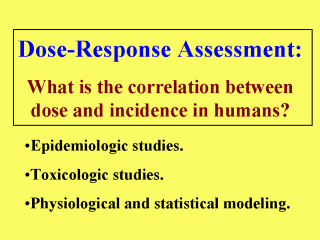|
|
|
|
front |1 |2 |3 |4 |5 |6 |7 |8 |9 |10 |11 |12 |13 |14 |15 |16 |17 |18 |19 |20 |21 |22 |23 |24 |review |
 |
The main objective of dose-response assessment is to describe the quantitative relationship between the amount of exposure to an agent and the extent of an adverse response (e.g., between dose and incidence). The harmful response is known as a non-threshold effect if it can be thought of as caused by a single or short exposure. A familiar example of this type is lung cancer caused by even passive inhalation of cigarette smoke by nonsmokers. It has been shown (Doll, 1978) that the annual incidence of lung cancer in cigarette smokers correlates well with number of cigarettes smoked per day. There is the notion, however, that even very small amount of exposure to cigarette smoke is capable of initiating the multistage process of (lung) cancer. As supported by other epidemiological and animal data, several other types of cancer (e.g., radiation-based) are also thought to fall into this non-threshold category. At the low-dose region, for which experimental data are usually not available, the incidence (i.e., the response) can be extrapolated only through use of some physiological or statistical modeling. This type of extrapolation is needed in that the ultimate goal of public health is to protect as many people in a community as possible, including even those exposed to very low dose. Models that support a threshold effect are also used for incidence extrapolation at the low-dose region, but typically for non-cancer type adverse response such as cholinesterase inhibition or reduced fertility. In this type of dose-response curves, it is assumed that no toxicological response occurs until a certain dose threshold is reached. |